Since its domestication some 5000 years ago, pig is now one of the important sources of meat across the globe contributing almost 35% of the total meat production worldwide (as per 2018 data). Similarly, in India, swine fanning endorses about 6.7% in the total meat production. According to 20th Livestock census, during 2019, the total pig population of the country counted to be 9.06 million contributing 1.7% of the total livestock population of the country. In the category of exotic or crossbred the tally touches 9.06 million whereas 7.16 million population in cases of indigenous or non-descript breeds. Assam being the topper with 2.1 million population inferring a 28.3% increase from the previous count, followed by Jharkhand with 32.69% and Meghalaya with 29.99% increase in pig population. This is the foremost indication that pig farming can be enhanced for better and faster outcomes, though, an overall decrease in the national population of the animal has been recorded. Despite of the social stigma, pig farming is gradually flourishing since the last two decades. This is primarily attributed by the emergence of favourable pork market conditions, improved pig technologies with easy accessibility. Nevertheless, with tremendous intact-potential and income scope on proliferation, pig as compared to other livestock species has vast prospects for quick monetary returns to the farmers conjecturing significant economic upsurge. Moreover, pork consumption has also increased in the last few years resulting in upliftment and proliferation of hotel-industry and fast-food chains across the country. Thus, this business has evolved as piggy banks for progressive and enthusiastic entrepreneurs and smart investors. Even governmental firms are also encouraging and popularizing the same for lucrative benefits.
There lie many advantages with pig farming with huge outcomes in a short period of time as compared to other rearing enterprises. Pigs are prolific breeders with high fecundity rates and possess a shorter generation interval. Even they have short gestation period of 114 days (3 months, 3 weeks and 3 days). Thus, a sow can farrow twice a year producing 6–12 or even more piglets in each farrowing. Besides, a mature sow can breed at an early age of 8–9 months. Hence, proving that the growth rate of pig-business is very high that also in a short phase of time. Furthermore, pigs possess the highest feed conversion efficiency, can be attained the marketing weight of 80–100 kg of fatteners at an early age of 7–9 months only and have the highest dressing percentage of 60–80%. Henceforth, selection of breeds also plays a role in piggery as indigenous breeds have the disadvantages of small size and undefined characteristics mostly, their growth is rather slower, produces smaller litter size and more importantly pork quality does not satisfy the optimum quality. Though they are well acquainted with local weather and are comparatively disease resistant. On the other hand, recognised and exotic breeds sharing better characteristics from various lines serve the desirable purposes. Large White Yorkshire, Landrace, Duroc and their crosses are common in Indian piggery and also are best suited in this environment. In fact, Large White Yorkshire is extensively used here.
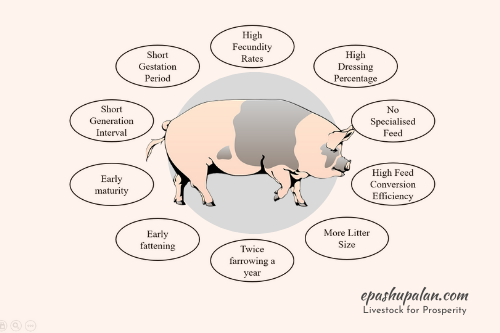
Even regarding their feed, grains, forages, damaged feeds, vegetables, garbage etc. are easily utilised by this cloven-footed animal converting into valuable nutritious meat. Pork provides more energy value with low water and high fat content; rich in niacin, riboflavin and thiamine. There is good demand for pork, bacon, ham, sausages, lard, bristles etc. in the domestic and international outlets. The largest pork importers include Japan, Russia, Hong Kong, China, South Korea and Mexico. The enterprises formulating value-added pork products including bacon, ham, salamis, sausages, pickles etc. are grasping a good market. As pig produce a good amount of lard (fat), this can be used as one of the most valuable by-products viz., soap, paints, poultry feed and sources for other chemical industries as commercial purposes. Similarly, pig’s manure is widely used as fertilizer for agriculture farms and fish ponds specially. Thus, composite farming can go the best taking advantage of piggery with fisheries.
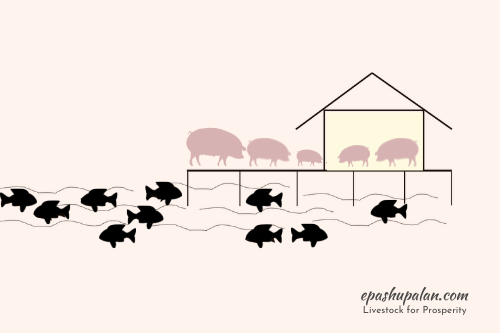
Fish farming in conjunction with pig farming will be more beneficial when fish polyculture is preferred over monoculture so that various trophic levels of the pond will be better utilised. Fish species, viz., Clarias catla, Labeo rohita, Cirrhinus cirrhosus, Cyprinus carpio, Oreochromis niloticus, Claria gariepinus etc. are common in the list as are can be successfully reared in the pond. It must be noted that fish seeds should be sourced from reputable fish hatcheries, stocking of fish should be in the range of 25,000–30,000 fingerlings, may be harvested after 4 months and for nine-month cycle. Care should be made for detection of water quality for the survival and growth of fishes. Water quality parameters be monitored on a regular basis to prevent mortality of the same. Prevention of algal bloom growth must be followed; excessive nutrient presence because of manure creating depletion of dissolved oxygen causing fish mortality be checked. Removal of algal bloom is prescribed otherwise.
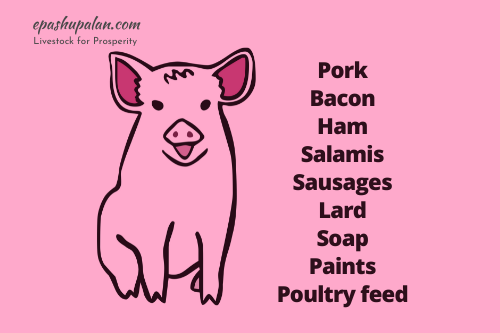
Hence, pig farming can be a boon to the pig farmers as it returns a huge investing a little capital. Though the amount solely depends on the size of the farm project but initial investments of breeding stock purchase, stock feed purchase and other related costs with lower housing expenses are required which is much lesser as compared to other livestock projects. Even management of pigs is also not much cumbersome, the farmer or the owner himself can manage without any helper if the herd strength is small. For purchasing a fully grown pig will cost around ₹ 8000–10000, initially it can be started with a boar and a sow too. Generally, the ratio of boar:sow is 1:15-20. The earnings depend on the age when a farmer wants to sell. Piglets can be sold for ₹ 3000–3500 each, fattened animals (100 kgs) for ₹ 8000–10000 each and pregnant sows for ₹ 15000 – 18000 depending on its parity. Therefore, if a farmer having two acres of land can easily uphold fifty numbers of animals resulting in 1000 pigs with a profit margin of 30 lakhs per annum. If fisheries is also considered along with, the margin increases much more.
So, from the above discussion, it is indicating that pig farming is a lucrative proposition for small and marginal farmers as well as bring a handsome return from national and international ventures.



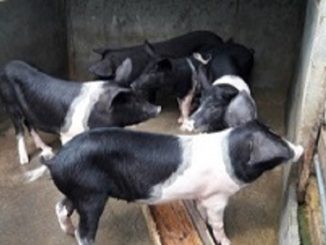
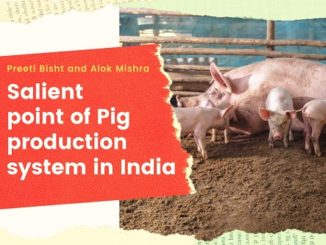

Be the first to comment